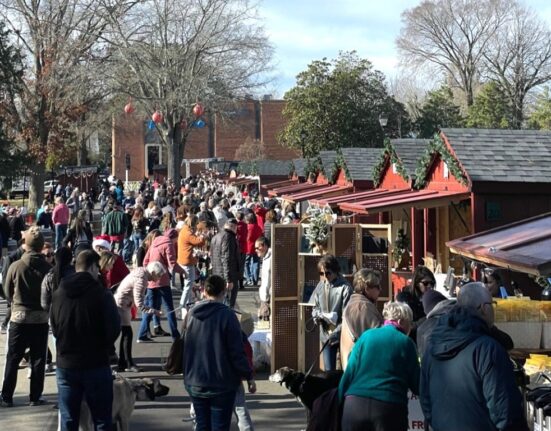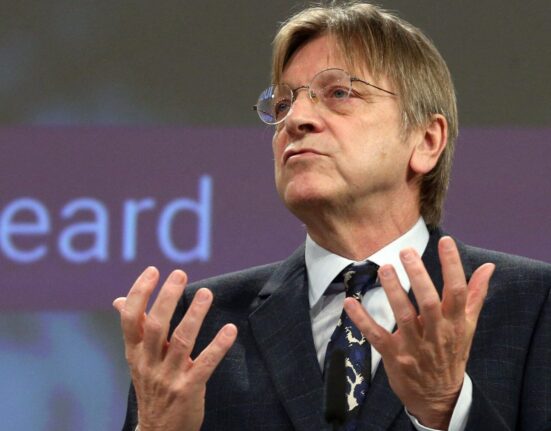Christmas at Kew opened this week and — as has been the case every winter since its launch in 2013 — its light-and-nature show is the best spectacle in town. Lamps cascade from trees, candles flicker in mid-air, abstract neon flowers sprout, the Temperate House is a fiery cathedral, LED lights skim the lake and multicoloured fountains illuminate the Palm House.
Few contemporary artists could match this — but step into Kew’s Shirley Sherwood Gallery and Mat Collishaw’s “Albion” immerses you in a silvery moonlit forest where a near-life-sized negative of a tree is projected across angled mirrors and transparent film, its gnarled trunk and spectral curling branches seeming to float. Captured by laser scanner, this is Sherwood Forest’s 800-year-old major oak, a tree connected to Robin Hood, a symbol of English endurance and strength, but actually hollow, rotten and held up by chains and crutches. In Collishaw’s rendering, the scaffolding becomes an eerie pattern of gossamer-thin lines.
It’s a vision of beauty in nature as ghostly, unstable, suspended between life and death: elegiac and meditative until, instants later, you find yourself under strobe lighting, pulled into the animated sculpture “The Centrifugal Soul”. Here a ring of bowerbirds peck, hover, flit, dance around bright, exotic flowers, the pulse as hectic as breathless teenagers at a nightclub.
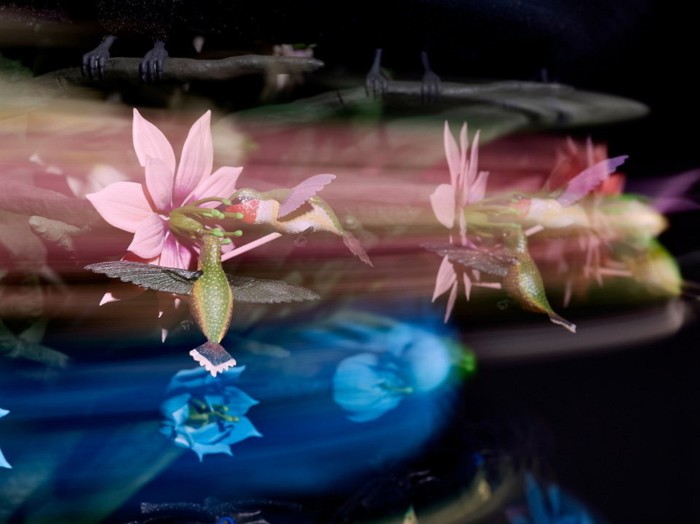
In the 1990s Collishaw was a Young British Artist, memorable for a self-portrait in the pose of an urban Narcissus, staring at his reflection in a muddy puddle in a concrete alley. He has had an intriguing, slightly under-the-radar career since. He is interested in our insatiable appetite for visual stimulation, which he sees as an evolutionary pressure — a need to be noticed above rivals, as compulsive in social media self-promoters as in birds endlessly circling the most garish flowers. His own art shifts inventively and unpredictably between genres, sensations, moods.
For Kew’s exhibition Petrichor (the term means the refreshing smell of rain on dry ground), each room is a competing environment in a different medium. Together they form a wonderland of past, present and futuristic images, fantastically interweaving Renaissance watercolours, Victorian zoetropes and French symbolism, AI creations, NFTs (non-fungible tokens) and more, as Collishaw delves into changing relationships between art, nature and technology.
He opens with a tribute to a revolutionary act of mimesis when, blade of grass by blade of grass, Albrecht Dürer in “Large Turf” (1503) made a detailed study of a clump of soil and its stems, roots and leaves, for the first time taking an ordinary piece of nature as a starting point for painting. In “Whispering Weeds” Collishaw reproduces and digitally animates the image to make the plants wave in a gentle breeze, bringing alive the excitement and optimism of nature transforming into art in 16th-century Europe.
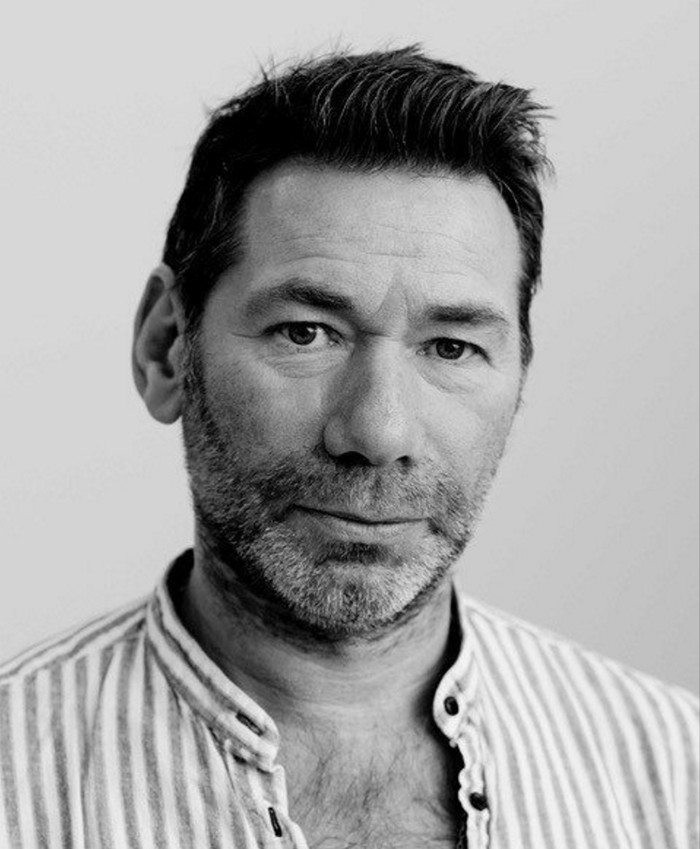
Dürer scholar Norbert Wolf says “Large Turf” marks a cultural moment of “the unity of perception, art, science and natural philosophy”. From such a delicate, hopeful beginning, Collishaw races through history, exploring how that balance became unhinged.
Already in the 17th century, representation of nature was moving from mastery of faithful depiction towards manipulation. Dutch flower paintings are as meticulous as Dürer yet stylised, overabundant and lavish, impossible scenarios combining blooms from different seasons.
For his new work “Alluvion”, Collishaw fed these floral still lives into an AI application, adding prompts referencing the insects that pollinate the plants. He painted the images generated as a series in oil on canvas — returning them to their original format so that from a distance they resemble Old Masters. Close up, every silken petal and luscious bud turns out to be a segment of an insects’ body, a fragile antenna, a fluttering wing, a beady eye.
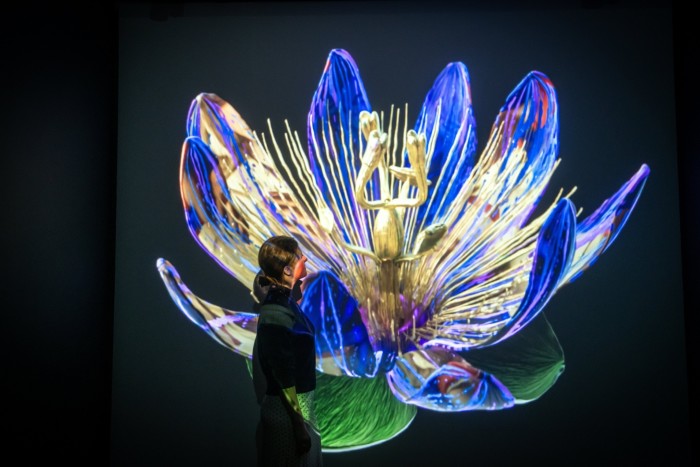
Bewildering and sinister, the paintings have names such as “That Incomprehensible Clarification”, “All Fathomless Others”, “Those Feverish Eyes”. The overall title “Alluvion”, referring to deposits from floodwater forging new landscapes, is a metaphor for how technologies — AI, social media — are washing over us, attracting us like insects to the flowers. Collishaw quotes sociobiologist EO Wilson: “The real problem of humanity is the following: we have Paleolithic emotions, medieval institutions and god-like technology.”
Concerns about genetic manipulation lurk in “Alluvion” and in the enamel-painted glass-and-resin flower sculptures of “The Venal Muse”, grotesquely sensual, enticing yet toxic. Purplish petals imitate diseased flesh, scarred and pitted, or tunnel-like, sucking in the air; crimson blooms are spiky, predatory.
Collishaw’s inspiration for his hothouse was Baudelaire’s Les Fleurs du mal and JK Huysman’s novel about artifice trumping naturalism, À rebours. Huysmans’ hero collects leprous and syphilitic-looking flowers, “skin ridged with false veins . . . livid surfaces of flesh veined with scarlet rash and damasked with eruptions”.
“Nature has at last been subjected,” Huysmans proclaims, “man now forces differently coloured flowers in the same species, invests new tones for her, modifies to his will the longstanding form of her plants . . . The horticulturalists are the real artists nowadays.”
Allusions thread through Collishaw’s show of speculation in overbred flowers, from tulip mania in the Netherlands in the 17th century to French fin de siècle obsessions with fanciful hybrids and exotic imports, symbolising for Huysmans his era’s decadence.
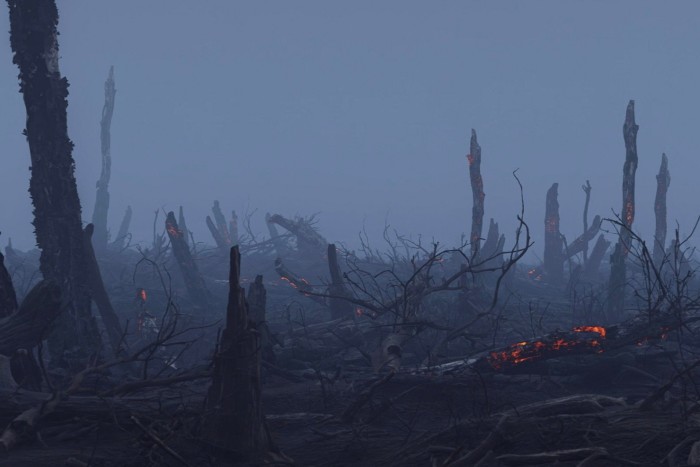
Made partly in collaboration with video artists in Ukraine, Collishaw’s new film “Even to the End” features the Wardian case, the 19th-century invention that allowed live plants to be transported between continents but was “instrumental in changing the Earth’s ecology”. To the accompaniment of Samuel Barber’s funereal Adagio for Strings, resounding across the galleries, Collishaw sets Wardian glass cases with precious plants to drift on the open sea, towards an island that evolves as we watch from fecund to burnt and ravaged. A final glimmer of the cases surviving on the horizon is a questioning note: can man’s ingenuity outpace his capacity for destruction?
The battle replays in Collishaw’s interactive digital metaverse “Heterosis”, launched in the spring. Now the horticulturalist-artists are NFT collectors: this fantasy digital garden consists of mutable flowers, taking the form of NFTs combining genetic algorithms with blockchain technology. Each token is a seed with a code; collectors pay to breed increasingly elaborate hybrids — pristine, glossy, surreal in their lurid hues and complicated designs.
Their virtual greenhouse is a post-apocalyptic version of London’s National Gallery, its grand halls, marble pillars, walls of pictures ruined, decaying, overrun by foliage as if, Collishaw says, “this old analogue world of painting has been neglected, destroyed, abandoned and this new burgeoning media of digital art in the shape of flowers is now taking over.” The project is a giant contemporary vanitas, also a satire on itself.
Petrichor is a visual extravaganza with a mind and a heart. Most eco-shows are grave and preachy. Collishaw’s is conceptual art at its most rewarding: curious, inventive and fun.
To April 7, kew.org
Find out about latest stories first — follow @FTWeekend on Instagram and X, and subscribe to our podcast Life and Art


